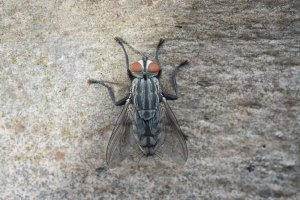Cluster flies can be pains in places too polite to mention, but they are different than other species and present their own form of nuisance.
Unlike their house fly cousins (Musca domestica) that invade picnics and kitchens during the summer, cluster flies first appear in early autumn along the sunny sides of residences, seeking ingress for the colder months of the year.
Once inside, they find refuge behind curtains, pictures and furniture as well as in cracks, crevices, voids in sheds; garages; barns, residences and any other type of man made structures.
They sometimes overwinter outdoors, close to the ground. Favored sites include: hedge rows; under the bark of decaying or dead trees and in the crevices of cliffs and rocks that face southward.
These flies are found mostly in Europe, North America, Australia, and New Zealand and they always seek refuge near humans.
They belong to the same family as blow flies and are believed to have made their way to the shores of North America in the ballast of European ships containing earthworms.

Their natural predators are rodents, particularly mice, and if you are witnessing a decrease in flies and an increase in mice scurrying about your property, it is likely you have two infestations to worry about, and it is way past the time to contact our pest-control and pest-maintenance specialists at Pestco.
Cluster flies are disconcerting because they fly about in large numbers, but due to the fact that they do not lay their eggs in food, they are not vectors of disease.
Although they are not known to cause significant damage to interiors, they often do leave dots of excrement on curtains, walls and any other places where they gather.
In the state of Pennsylvania alone, cluster files may produce as many as three or four generations per season.
The adults leave the nest in the spring and lay eggs on the soil, which contains earthworms, wherein the hatching larvae enter and develop to adults to begin the life cycle again.
Cluster flies are slightly larger than others, up to 1/2 inch in length vs. the 1/4 inch for a common housefly, and they are darker and slower moving.
They are deep gray in color with black markings and golden hairs on the thorax. A black and silver checked pattern covers the abdomen.
There are many hairs on the underside of the thorax near and between the legs.
9 Interesting Facts About Cluster Flies
1. Cluster flies are dormant and do not reproduce in the walls of an infested home.
2. This species makes loud buzzing sounds and are often found clustered on glass windows or walls that are heated by the sun. They creep along edges and fly much slower than other types, which makes them easy to capture.
3. These flies tend to disappear as warmer weather arrives, unlike house flies that reach their peak of indoor activity during the heart of summer.
4. Cluster flies live longer than other species. Under ideal conditions, adults can live as long as two years. Houseflies typically live for about 15 to 30 days, depending on temperatures and living conditions.
5. Cluster flies have several names. They are also known as attic flies because when they find ingress, they are known to gravitate to the highest part of the home. Their other moniker, grass flies, derives from the fact that these insects prefer to live close to the ground.
6. Cluster flies can be problematic if they are near areas of irrigated turf grass, rivers or streams and other locations where soil is moist.
7. By the time cluster flies are noticed on windows in a home, they are most often dying or dead.
8. They are not “filth flies,” as they do not develop in decaying plant matter or garbage, but rather as parasites within the bodies of earthworms.
9. Cluster flies rarely die indoors, and the great majority that spend their lives inside buildings emerge outdoors in the early spring, repeating their normal life cycle.
Cluster Fly Control and Prevention Tips
Our pest-maintenance specialists at Pestco advise Pittsburgh homeowners to take heed of the following suggestions.
Mechanical (Physical) Exclusion
This includes sealing cracks around windows, doors, siding, utility pipes and behind chimneys with good quality silicone or silicone-latex.
It also means the replacement and/or repair of any screen doors or windows that may be damaged. If there is no way to seal them out, these insects cannot be prevented from entering the premises.

Buildings must be sealed and protected before these flies can penetrate wall voids and attics, at the very least in mid August and no later than Labor Day.
When sealing, pay particular attention to the sun-exposed sides (south and west) and upper areas of the building where they are most likely to seek ingress.
Exterior (Chemical) Applications
Sprays and Insecticides
Home owners can create a protective barrier by spraying the perimeter of the yard with a plant-based insecticide spray that will help keep cluster flies away.
While they may offer some relief, completely sealing off the exterior is difficult at best.
Cluster flies avoid certain scents such as lavender, eucalyptus, peppermint and lemon. Indoors, sprays with these fragrances will keep them at bay and add a pleasing touch of scent in the home.
They cannot, however provide a solution for long term management. For best results, call the pest-control and pest-management experts at Pestco because do it-yourself remedies are not likely to work after a few days or at most, a week.
The management power of insecticides when dealing with cluster fly infestations is somewhat limited. Residual insecticides can be applied as sprays targeted to cracks/crevices on building exteriors in late summer.
This is effective, but only as a supplement to the vitally important focus of sealing off potential entry points.
Both over-the-counter and commercial formulations are available, but all of them should only be used as targeted applications to cracks and crevices found around the outside of windows or openings in soffits.
It is also not advisable to use an insecticide after cluster flies have infested wall voids or attic areas because even though it may kill thousands of flies, carpet beetles will become attracted to the carrion and not only feed on the carcasses but also attack woolens, stored dry goods and other natural products found in the home. It would seem like that old expression, damned if you do, and damned if you don’t, might well apply here.
Drying Dusts Applied Behind Walls
This second type of insecticide application involves the use of a desiccant/drying dust type that is injected into voids behind walls and other areas where cluster flies congregate.
This can kill insects that have gained ingress to a building, which deters progression into living interiors, but dead insects behind the walls can attract rodents, beetles and other unpleasant visitors.
The pest-control and pest management experts at Pestco can ensure that these desiccant/drying dusts are most effective, but they require special equipment that the average home owner is not likely to have on hand.
Light Traps Used In Areas behind Walls, in Attics.
Fly paper or traps with food or chemical lures do not appeal to cluster flies. Light traps situated in in large open areas, however, such as attics, can work effectively.
Light traps can be attractive and work well within buildings in open areas since these flies move through corridors provided by drop ceilings and are easily intercepted.
The most effective light traps are those that utilize ultraviolet lights. Their sticky surfaces attract and trap cluster flies.
Pittsburgh Pest Control Solutions
If you are a Pittsburgh homeowner whose residence has been infested with cluster flies, contact the pest-control and pest-maintenance specialists at Pestco as soon as possible!
We’re a five-star, family-run business that has been in continuous operation since the late 1940s, and we proudly provide the friendliest, most effective pest control service throughout all of Greater Pittsburgh!

 Over 300 Reviews
Over 300 Reviews 